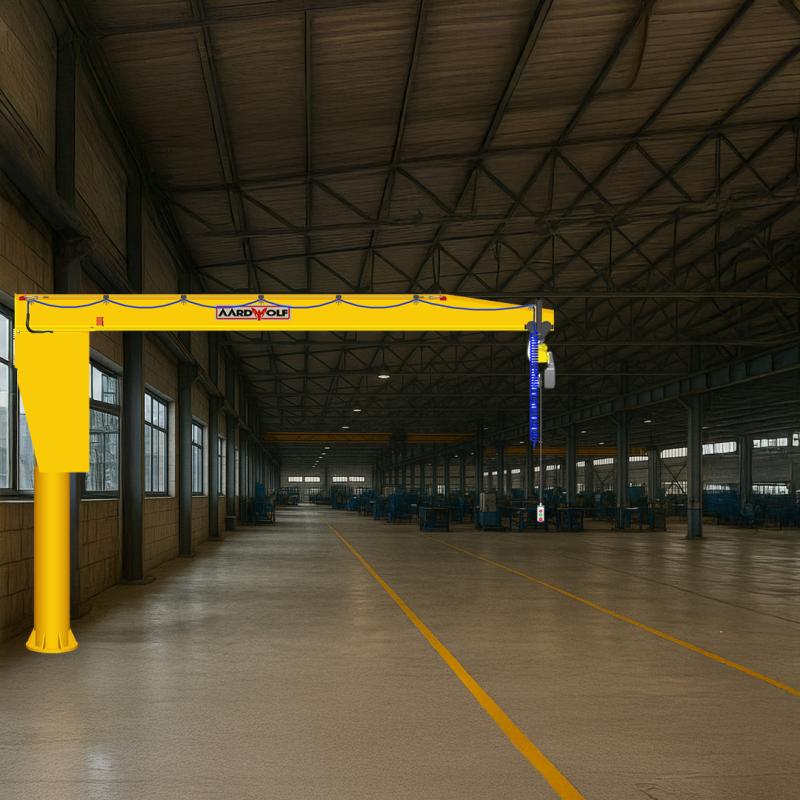



One of the most versatile lifting solutions used in workshops, warehouses, and manufacturing plants is the freestanding jib crane. Known for its strength, adaptability, and full-circle coverage, this type of crane is a standout among various jib cranes available in the market.
In this article, we’ll explore everything you need to know about freestanding jib cranes—their structural features, key advantages, and industrial applications—while also comparing them with other types of jib cranes.
To explore the full range of Jib Cranes, visit Aardwolf’s product family page.
A freestanding jib crane is an independent lifting system mounted securely to a concrete foundation. Unlike wall-mounted or ceiling-mounted cranes, a freestanding model doesn't rely on building structures for support. Its design typically includes a vertical mast and a horizontal boom that rotates—either manually or electrically—around the mast. Most freestanding jib cranes provide 360° rotation, offering complete circular coverage of a workstation.
This crane type falls under the broader category of jib cranes, a class of equipment designed to perform localized lifting and movement of materials in specific work zones. Learn more about the various Jib Crane Types to see how freestanding models compare with wall-mounted or articulated alternatives.
One of the most valuable features of a freestanding jib crane is its full 360° rotation, which allows for maximum operational flexibility. This is especially useful in open floor spaces where workers need unrestricted lifting movement.
Freestanding jib cranes are engineered to handle substantial loads—typically ranging from 125 kg up to 5,000 kg or more—depending on the design and boom length. The sturdy base and vertical mast offer the necessary structural integrity to lift heavy objects safely and consistently.
Unlike wall-mounted or ceiling-mounted options, freestanding models require no external support. They are mounted on a reinforced concrete foundation, which means they can be installed wherever lifting is needed—independently of walls, ceilings, or other building features.
If you're planning installation, consult this step-by-step jib crane installation guide to ensure a secure and code-compliant setup.
Freestanding jib cranes can be custom-designed to match the height of your facility and the required boom span. This allows precise integration into diverse workflows without obstructing surrounding machinery or personnel.
While all jib cranes serve the purpose of lifting and moving materials efficiently, freestanding jib cranes offer several unique advantages compared to other types:
| Feature | Freestanding Jib Crane | Wall Mounted | Ceiling Mounted | Articulating |
|---|---|---|---|---|
| Load Capacity | High | Moderate | Moderate | Light |
| Rotation Range | 360° | 180° | 180°–360° | Variable |
| Requires Wall/Ceiling Support | No | Yes | Yes | Yes/No |
| Custom Height/Boom Options | Yes | Limited | Custom | Yes |
| Installation Complexity | Moderate | Low | High | Moderate |
To understand the difference between a crane and a jib crane, Aardwolf provides a helpful article comparing structural forms and lifting use cases.
Freestanding jib cranes are used across a variety of sectors due to their ability to serve both heavy-duty and repetitive lifting operations.
In warehouses, these cranes streamline the loading and unloading of goods. Positioned near loading docks or conveyor systems, they help reduce reliance on forklifts for short-range lifting tasks.
Fabricators rely on freestanding jib cranes to move heavy parts, tools, and raw materials to and from CNC machines, cutting stations, and welding bays. The 360° range is ideal for circular work areas or shared work zones.
Whether lifting engines, vehicle components, or specialized machinery parts, freestanding jib cranes offer safe and controlled lifting near workbenches and inspection zones.
Used outdoors or in stone slab yards, these cranes are perfect for lifting heavy granite or marble pieces. Combined with hoists or vacuum lifters, they provide secure handling of delicate yet bulky materials.
Installing a freestanding jib crane requires proper foundation design and planning. Key considerations include:
Foundation Depth and Reinforcement: A typical concrete base is 1.2 m deep and reinforced to withstand dynamic loads.
Clearance Requirements: Ensure there’s adequate room around the crane for safe rotation and load travel.
Power Source: For motorized rotation or electric hoists, access to electrical wiring is essential.
Refer to Aardwolf’s guide on how to install a jib crane step by step for full technical instructions and site preparation tips.
While freestanding jib cranes provide the most flexibility and lifting power, other types like wall mounted, ceiling mounted, and articulating jib cranes may be better suited for certain environments:
Use a wall mounted jib crane if you need to save floor space and have existing structural support.
Choose a ceiling mounted jib crane when floor and wall space are fully occupied, and you need overhead lifting coverage.
Opt for an articulating jib crane for applications that require movement around machinery, corners, or obstructions.
To evaluate all models, read: What are Jib Crane Types?
Freestanding jib cranes are one of the most reliable and powerful lifting solutions for modern industry. Their standalone design, high capacity, and full rotation make them suitable for virtually any application—from warehouses and workshops to fabrication and outdoor environments.
If your operation demands continuous, high-capacity lifting with maximum flexibility, a freestanding model is a top-tier investment among all jib cranes. Whether you’re upgrading your material handling systems or planning a new installation, freestanding jib cranes provide the durability and efficiency your workflow needs.
References
1. How to operate a Jib Cranes safely
3. Over brace jib crane wall mounted
5. Is a Jib Crane a Gantry Crane
6. Articulated Jib Crane Wall Mounted
8. Manual Counterbalance Crane
10. Over Braced Jib Crane Column Mounted
Sign up to receive the latest info on new Aardwolf products, special offers and more.
By signing up you agree to receive emails from Aardwolf with news, special offers, promotions and other information. You can unsubscribe at any time.